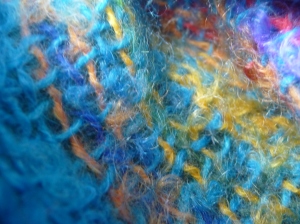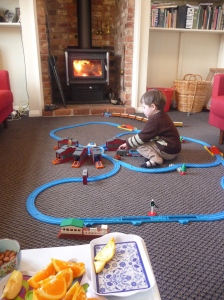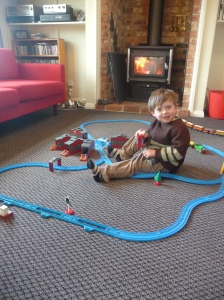little red jottings
Tag: coffee and a book
12 May 2015
An island, a mother, the rain
 If this blog could be said to have any kind of theme, it might be mothering. Or rain. This year, as with the last, it looks like my Mothers’ Day post is doing the combo, not that it rained on the day, but that it takes a day or two of settling and the clouds to open before I can sit down and write it out. At the opening of the Dunedin Writers and Readers Festival last week, Witi Ihimaera asked us how we might define New Zealand Literature, and all I could think of was that in a New Zealand book it will usually rain somewhere along the line. More on that in another post.
If this blog could be said to have any kind of theme, it might be mothering. Or rain. This year, as with the last, it looks like my Mothers’ Day post is doing the combo, not that it rained on the day, but that it takes a day or two of settling and the clouds to open before I can sit down and write it out. At the opening of the Dunedin Writers and Readers Festival last week, Witi Ihimaera asked us how we might define New Zealand Literature, and all I could think of was that in a New Zealand book it will usually rain somewhere along the line. More on that in another post.
It’s a lamps and fire and rain on the windows kind of day here, some gold still in the trees, the house firm and old and quiet. It’s a pondering sort of day, and I do like to ponder.
Mothers’ Day was a bit *different* this year. I woke to the alarm at 6.20am, which is about my least favourite way to wake up, then had breakfast on my own. When I opened the cupboard to get the coffee, I found a postcard of Paris from Ian, who was away for work. I’m a total sucker for that sort of thing: coffee, Paris, loving words in black ink, an empty kitchen, a solitary breakfast — it was a pretty zen start to the day.
It became more of a scramble at 8.15am when I had to get the boys out of bed and out the door by 8.30am, but thank god they were going to my sister because I could shove a pack of crumpets and a pile of fruit in a lunchbox with no qualms whatsoever. The Cat gave me a card covered in soccer drawings (a number 10 jersey with my name on it, a soccer pitch with me scoring a goal, a Barça shirt, etc), with the message that I should “keep being awesome”. I put the card in the cupboard next to the postcard and I see them whenever I’m looking for coffee or honey or butter.
I dropped the boys, collected my father and took him to a talk on tramping in New Zealand. Afterwards, I found my sister, her partner, their baby and my boys playing soccer in the park. The sun was warm, the grass was wet, everyone was in good cheer. The Squirrel-baby is learning how to hug; he reaches towards you with his arms out and leans on whatever bit of your body he lands against. It’s basically the most excellent thing ever.
 The afternoon was more soccer, the library, a quick walk in the Gardens. We got home a little too late, with too many chores to do, dinner to make and everyone losing it at 5.30pm. Ian sent messages from Stewart Island, where he was tracking —of all people — Prince Harry. He managed to spend some time at the place where Mum’s ashes are, and I was caught out by the thought of him being there, of the Mothers’ Day I wish I could have, of the pull of that beautiful, honest, gentle place.
The afternoon was more soccer, the library, a quick walk in the Gardens. We got home a little too late, with too many chores to do, dinner to make and everyone losing it at 5.30pm. Ian sent messages from Stewart Island, where he was tracking —of all people — Prince Harry. He managed to spend some time at the place where Mum’s ashes are, and I was caught out by the thought of him being there, of the Mothers’ Day I wish I could have, of the pull of that beautiful, honest, gentle place.
 Spaghetti with prawns and peas smoothed most of the feathers, a glass of wine a few more, cuddles most of the rest. But my dear old Cat was still a bit spiky. It took all evening, but he finally told me that he was feeling bad because he’d realised that I’d only done things they liked on Mothers’ Day, not the things I would probably like to do. I held him close and told him about how happy it makes me to see him and his brother doing the things they enjoy, about the struggle it is to get dinner on the table when I’m tired and my children are fighting, about how touched I was that he’d thought about what the day might have been like for me.
Spaghetti with prawns and peas smoothed most of the feathers, a glass of wine a few more, cuddles most of the rest. But my dear old Cat was still a bit spiky. It took all evening, but he finally told me that he was feeling bad because he’d realised that I’d only done things they liked on Mothers’ Day, not the things I would probably like to do. I held him close and told him about how happy it makes me to see him and his brother doing the things they enjoy, about the struggle it is to get dinner on the table when I’m tired and my children are fighting, about how touched I was that he’d thought about what the day might have been like for me.
He hugged me back, tight and warm, and that was the best of the day, right there.
29 April 2015
A thick layer of wool
We got insulation put in the roof last week. What a revelation! We still need heating on cold days, but the HEAT STAYS IN. And there’s not that slightly chill draughty feeling at the far end of the woodburner’s reach. And the windows are dry in the morning. We could do plenty more, and may as budget allows, but for a quick, long-term, not terribly expensive improvement to your house, it would be hard to go past insulation.
When I say ‘not terribly expensive’, I mean around $1200, so not peanuts either by any means, but not in the realms of a new roof, piling, major redecoration, etc. And I cannot understand why landlords don’t all do it. For sure, they don’t get the direct benefit — not living there and not paying the power bill — but wouldn’t some sort of social conscience prompt you to give your tenants a fair shot at being warm? And wouldn’t it be worthwhile to make your house warmer, therefore drier, therefore likely to stay in good nick for longer?
We need it now, too. The colours have turned across the city, the days are getting shorter, it’s the letting-go time. Some days I want to step out into it, others to stay home, light the fire, brew coffee, hunker.
26 November 2014
Marmalade days, Part II
I picked up Shonagh Koea’s book, The Kindness of Strangers {Kitchen Memoirs} at breakfast this morning, and I’ve been rolling her words like marbles under my tongue all day. I could start quoting anywhere, really, and my stopping point will be likewise borderline arbitrary, but I thought, y’know, marmalade.
The first time I made marmalade was when I was working as a very junior reporter in New Plymouth. The Daily News was a morning newspaper so we all worked until eleven at night, or even later, and no one wanted boarders going in and out of their houses at that hour so I had a tiny flat of my own. There was a tiny kitchen with a kauri bench and a very old-fashioned gas stove on cabriole legs. It had a mottled blue and while enamel surface and I always thought it was rather pretty. I made my first batch of marmalade on that stove and when I had poured it into the jars and left it to set on the bench I thought it looked truly beautiful, so golden and glittering and clear.
This tiny flat was the first home I ever had of my own and I liked it very much. It was very quiet and looked out on to large trees. When I stepped into the place it was always quiet and exactly as I had left it. In Hastings, my father had a habit of suddenly arriving home in his big car, loading it up to the roof with anything nice like crystal glasses or the better blankets or anything he thought was worth having and, with much shouting, driving away. He would not return for several months. That is why when I had that first little flat it pleased me very much that whatever I had, and it was not much, remained where it was. If I had a coat hanging in my wardrobe when I left for work the same coat was hanging in the same wardrobe when I got home. I found the idea of that absolutely charming. Possibly it was the first time I had any reliable sense of security.
The marmalade I made then is essentially the same recipe I still use but I have altered it slightly over the years. I now take no notice of the recipe’s instructions about when the mixture is ready to be put into jars to set because, for marmalade, the timing often varies with the ripeness of the fruit.
To Make Marmalade
six large grapefruit
four lemons
12 cups of water
12 cups of sugarSlice the grapefruit and lemons as finely as you can, after washing the fruit carefully. Cover the sliced fruit with the water and leave overnight. The following day bring this mixture to the boil and boil for twenty minutes. Remove the jam pan from the heat and stir in the sugar, bring the mixture quickly to the boil after that and boil it for thirty minutes. At this stage you can start testing it to see if it will set. I used to put a spoonful in a saucer and leave it for a minute or two to see if a skin would form on it but after several years of my using this not overly reliable method, an elderly lady I knew told me a very handy trick. It had been passed on to her by her mother. She said to dip an ordinary silver or stainless steel tablespoon into the mixture and then hold it horizontally over the marmalade so you are looking at the wide inner face of the spoon. When the marmalade drips off the lower edge in two separate places simultaneously the marmalade is ready to be put into the jars. It sometimes takes much longer than thirty minutes’ boiling to accomplish this but it is a very reliable method, I have found. When I first started to make marmalade I used to put the clean empty jars in a slow oven to sterilise, about the time I put the sugar in the mixture. Then I would have to get them out one at a time — and they would be hot — with an oven cloth, in a sudden untidy kind of scramble. But these days I put them neatly in rows in a roasting dish and then I just have to get the whole lot out at once and any drips of marmalade, when I fill the jars, are caught in the dish.
[Interlude for a marmalade loaf recipe and time to marvel at the genius spoon and roasting dish methods which, collectively, would eliminate about 80% of my previous marmalade trauma, then…]
Another very nice loaf I sometimes make has no marmalade actually in it, but I put marmalade on it and sometimes make it instead of having ordinary bread. It is a bran teabread and is very pleasant to have sliced and buttered and spread with marmalade for breakfast at a weekend when I go out to my little garden house to read the paper and have a look at my wilderness (which is really only about as big as a tennis court, if that). I have cultivated quite wild and spreading plants so there is an atmosphere of largesse and tropical wilderness in my garden and through this I walk carefully with a cup of coffee in one hand and a doorstep of homemade bran loaf spread with marmalade in the other. Once I tripped on a low-lying leaf of my big flax plant and fell flat on my face, so I have walked through my garden with greater care since then. I had thought, as it was my very own garden, that I would be able to do anything there and be unharmed but this was just a fanciful thought — I am apt to have such fancies and think that because it is me everything will be all right. It mostly is but sometimes not, like the time I tripped over the flax leaf.
Shonagh Koea, The Kindness of Strangers {Kitchen Memoirs}, Auckland, NZ: Random House, 2007 (pp. 32–35).
27 October 2014
Falling through the cracks
 Okay, so I have a weakness for pottery. Also, coffee, dairy products, bacon, flowers, books, lemons, French desserts and vegetables.
Okay, so I have a weakness for pottery. Also, coffee, dairy products, bacon, flowers, books, lemons, French desserts and vegetables.
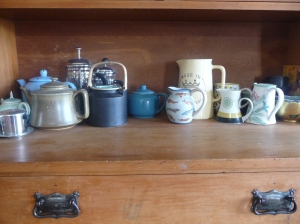 I did classes once and loved it, but I couldn’t master the wheel or anything involving the addition of water, so all my creations were small, misshapen and bottom-heavy. I love them anyway, and one day I’ll try another course.
I did classes once and loved it, but I couldn’t master the wheel or anything involving the addition of water, so all my creations were small, misshapen and bottom-heavy. I love them anyway, and one day I’ll try another course.
The Dunedin Pottery Collective has a shop in town, and I should never go in, really, because the prices are reasonable enough to make it always seem like a good idea to buy something, and there’s always something pretty enough to tempt me, and if I take a child, they’ll find something too — a little clay animal or a cup or a bowl. I don’t usually do much impulse shopping or retail therapy, but I do in there.
Anyway, a little while ago I went in because I have poor self-discipline and I secretly believe in indulging my weaknesses, and I came out with two cups, a jug, and a little cat for each of the boys. I knew as soon as I walked out that I had just set myself up for that awful mix of joy and guilt and shame and happiness that comes with unauthorised, beautiful and impractical purchases, but then I really compounded it by cracking a cup and the jug on the way home. I don’t know how it happened; I carried the Rabbit, caught the bus, walked up the steps, dropped my bag, and somewhere in there disaster struck. Quite amazing, actually, that anything survived.
So, there I was, all guilty and sad and bereft until Ian couldn’t stand it any longer and told me to ring the shop and let them know what had happened. The negotiations that followed were fraught and protracted, not because the potter and I we were trying to get a good deal out of each other, but because both of us wanted to be fair and generous, while also both being a bit useless with numbers and the arithmetics of the situation. And out of the awkwardness, I emerged with a new cup and jug and less money. ALL GOOD.
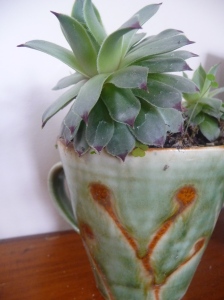 I also decided that I could make myself feel better by putting plants in the cracked vessels, so I bought a succulent that I divided and tucked in with soil and a little fresh water, sort of a new life from old, growing things in a broken world, converting beauty to a new form kind of a deal.
I also decided that I could make myself feel better by putting plants in the cracked vessels, so I bought a succulent that I divided and tucked in with soil and a little fresh water, sort of a new life from old, growing things in a broken world, converting beauty to a new form kind of a deal.
This cup is actually another cup I had, which cracked in the course of a revolting two-day, Skype-based hui for an organisation I’m part of — something had to break in that meeting, and in my rational mind I’m glad it was a cup, even though it had been my perfect elevenses coffee cup and it was the need to replace it that took me into the Collective shop in the first place.
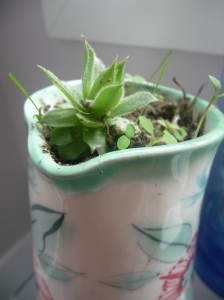 So, now that we’ve come all full circle on this story, I have to tell you that when I looked at the jug plant the other day, it had tiny green weeds growing in it. This seems very metaphorical and really quite adorable to me. I am, essentially, a total dag.
So, now that we’ve come all full circle on this story, I have to tell you that when I looked at the jug plant the other day, it had tiny green weeds growing in it. This seems very metaphorical and really quite adorable to me. I am, essentially, a total dag.
21 September 2014
The next day
A flat day here, made better by the following:
- a jonquil, brand new
- Rabbit falling asleep on Ian on the couch, with bonus snoring
- new business cards and flyers
- a fire and no great expectations
- coffee and cake
- handmade mugs
- yoghurt
- Ani d’Franco: “all of this is just someone’s idea; it could just as well be mine”
- rain, grey sky and a green jersey
- the Cat’s face, clear and open, with bonus freckles
- gin and tonic, and no, I am not a complete lush
I thought I could be completely trivial today and write about clothes. Not my speciality, obviously, but I do wear them and I have thoughts.
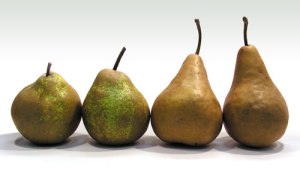 The first thing that must be acknowledged is that I’m irreducibly pear-shaped. I’m fairly at peace with that — I fit the prototype passed from the women of both sides of my family, so at least I have lineage — but I would like to aim more for the Buerre Bosc end of the spectrum than the Winter Nellis one.
The first thing that must be acknowledged is that I’m irreducibly pear-shaped. I’m fairly at peace with that — I fit the prototype passed from the women of both sides of my family, so at least I have lineage — but I would like to aim more for the Buerre Bosc end of the spectrum than the Winter Nellis one.
Being pear-ish, fashion doesn’t work so well for me as playing to my strengths. I have finally made the move from flared trousers and fitted tops to narrow pants and looser tops, at least in my head. I don’t go shopping very often and I don’t like replacing clothes that still fit and don’t have holes, so my wardrobe is a bit slow to catch up. Also, there’s a very narrow range in which narrow pants work for me: leggings, jeggings, skinny jeans, and ponte pants (whatever they are) are usually BAD NEWS, unless they achieve some miraculous combination of arse-friendliness and leg-forgivingness. This miracle is usually only achievable with the addition of heels; as I like to walk, we don’t see that miracle in these parts very often.
I have a bone-deep weakness for cardigans and woolly hand-knits. If it’s soft, drapey, snuggly, and the right colour, I’m ALL IN. The right colour is tricky: I’m partial to greys, greens, blues and certain reds. A soft pink has been known to lure me, and a stripe will usually find its way to my heart. Silver is also good. Mum had an aversion to black that verged on moralistic, so even though I admire all-black ensembles on my friends, I usually wear colour unless we’re talking nightwear. I had a pair of black silk pyjamas in my 20s with white edging, and they were THE BEST. In the last year, I’ve relied heavily on scarves to brighten up my days.
I don’t like to linger or browse in clothes shops; I’m more your “walk in, scan the racks, pull out five things, try them on, make decisions, buy or leave” type. I like an honest salesperson and help thinking of different options, but I can’t stand being talked into something that doesn’t work. If the whole operation can be done in less than 15 minutes, so much the better. Most of my best buys have been second-hand, and my only problem with that is the need to fossick in larger second-hand stores. I’m quick, but I like to know that I’ve seen everything, so vast choice makes me twitchy. I can sew skirts and simple tops, but buttons and zips are at the outer limit of my skill range.
I’d like to own a silk shirt like the ones Allison Janney wears on The West Wing (although she is longer and leaner than me, so maybe not — also Mum kept silk shirts in the freezer to make them easier to iron, and I’m not sure I’m game for that), a pair of slightly heeled ankle boots, a slouchy grey jersey to replace the one I’ve had since I was 17, better pyjamas, and a bra to replace the one that saw me through Rabbit’s breastfeeding years. One day…
21 July 2014
Will you read with me?
My great-aunt told lovely stories about her parents, her mother Mary and her father Percy. Percy was quiet, a bit of a socialist, a reader. Mary was a cheesemaker, a manager, a maker-doer. She would invite everyone for Christmas dinner and he would go out and dig his turnips. In the evenings, Percy would read by the fire, and I imagine Mary would knit or sew or make elaborate plans and organisational lists, not that I’m projecting or anything. After a while, she’d crack it and say, “Do talk to us, Percy.” And he’d slowly put down his book or paper, take off his glasses and look around like a mole emerging into sunlight from the dark and fragrant earth. He might talk then, a little bit, but after a while he’d retreat back into his book and silence would fall again. Not that I’m projecting or anything.
So, I guess what I’m saying is that there’s precedent, and it’s taken me a long time to realise that not everyone holds with reading in company. Some people find it disconcerting and kind of rude, and they want you to come out and talk to them or at least keep an ear open for what they’re saying.
But we readers go a long way under when we’re reading, and spoken words take a long time to reach us down there. Surfacing takes effort, and we don’t function so well bobbing about with the chat and the questions and all. Haul me out of the water and talk to me on dry land or let me sink back down. Better yet, join me underwater. My sister knows how this works. Every now and then we’ll go out for coffee, and somewhere between the stories that must be told and the ordering of drinks one of us will ask if it’s okay to read. Then we’ll sit there, coffee at our elbows, books in our hands, and read together. Together and apart.

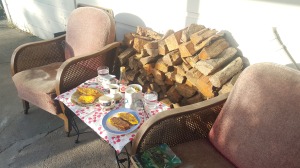
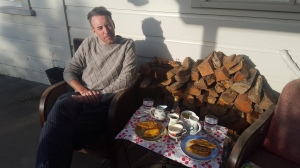

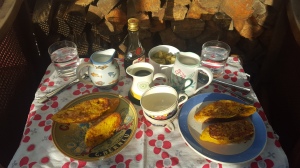





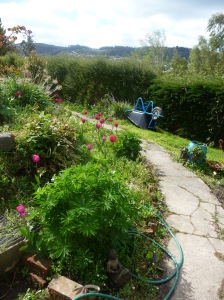
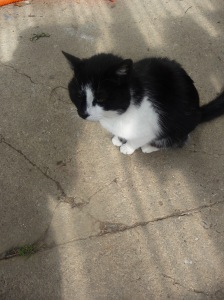


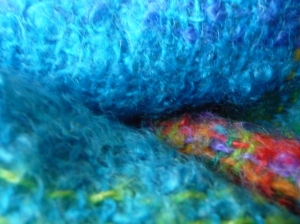 Today: brought to you by wind, rain, hail, sun, train tracks, fruit, fire, almonds, oatcakes, coffee, books, and all the blankets.
Today: brought to you by wind, rain, hail, sun, train tracks, fruit, fire, almonds, oatcakes, coffee, books, and all the blankets.